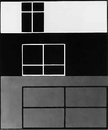Leadline 1994: Josef Albers: Works in Glass (Part Five)
 by Jason Peter Brown on June 18, 2007
by Jason Peter Brown on June 18, 2007
 Filed Under: REPRINTINGS, LEADLINE
Filed Under: REPRINTINGS, LEADLINE
This is a reprinting of the final part of a five part original article on Josef Albers by Doreen Balabanoff. It originally appeared in Leadline in 1994. You can read Part One here.
The weaving studio, considered an important Bauhaus workshop, is also cited as a possible source of influence. Finkelstein notes the regular, rectangular grid structure intrinsic to all weaving, and the overlapping and rhythmic reversals of figure and ground which seem to have surfaced in Albers work at this time (he married weaving student Anneliese Fleischmann in 1925).
"The glass compositions… that are most strongly suggestive of a cross influence with weaving span the period between his marriage in 1925 and about 1929… in all of these are found the regular vertical beat and horizontal rhythm of modular widths, either repeated, doubled, tripled, etc, that were observed in 'Skyscrapers' and 'Overlapping'. However, one sees… a far stronger quality of all the patterns being totally interlocked or interwoven… [so that] it is impossible to say whether the white, red or black is the ground colour."
It is worth noting, too, that through this series of works, Albers had hit upon the idea of "creating groups of works that were 'variants' of a given theme" - an idea which provided a model for his later works, and has indeed been adopted by the art world at large as an almost 'a piori' expectation for a 'consistent' body of work.
By 1929 Albers had moved to the exclusive use of black-flashed-on-white glass, and was using a 3-toned achromatic image of black, white and gray. The window motif provided the subject matter for a series of works in which the notion of reversal was played with explicitly. Albers had evolved towards an "extreme minimization and geometricization of form… using arithmetic and geometric progressions to set up the sizes of the compositional elements". Finkelstein quotes a 1962 article in the Artists Voice in which the reviewer comments, "the painting on glass called 'Interior' used the window theme and was the fourth in a connected series of 29 works". Only four of these remain extant today.
In the last few years of production, from 1929-33, the glass works move into highly graphic, representational drawings of objects: folded and rolled paper, a piano keyboard, glove-stretchers, etc. Increasingly Albers was exploring the illusionistic possibilities of black, white and gray, achieving illusions of transparency, shade and shadow as well as light.
The Bauhaus moved to Berlin in 1932, and Albers had his first solo show there - a comprehensive exhibition of glass works from 1930-32. When, in 1933, the Nazis forced the Bauhaus to close its doors, Black Mountain College, an experimental college in South Carolina, was just opening its doors. Phillip Johnson, then at the Museum of Modern Art, had visited Albers' classrooms at the Bauhaus, and it was upon his recommendation that the college contacted Albers and invited him to set up the art program there.
On November 28, 1933 Josef and Anni Albers arrived at Black Mountain College. Without access to the glass materials and technology that had been readily available to him in Germany, the glass works came to a sudden halt. The demands of learning a new language, developing a program of study and adjusting to a new world left little chance to look back. Albers was on to new experiments, in printmaking and painting - though the initial works were strongly connected to the visual images used in the glass works.
Albers never again returned to the autonomous panels. Unquestionably, the lessons from his work in glass made their way into subsequent work in murals, paintings and design, as well as into his colour course. Even the black and white phase of his glass work (coming at the time when Bauhaus members faced increasing political pressure and life in Germany was becoming more and more difficult) should not, I believe, be seen as a denial or disinterest in colour, but rather as a process of distillation and reduction typical of Albers' creative methodology. By reducing down to essentials, he was able to focus attention on phenomena often lost in more complex work.
Of the many lessons available to us in these works, perhaps this is the most important… It certainly was one which Albers himself carried through into the rest of his life. His works in glass make accessible Albers' singular process of conceptualization. Simple, even severe, they show us a creative mind at work.
This concludes the series.
